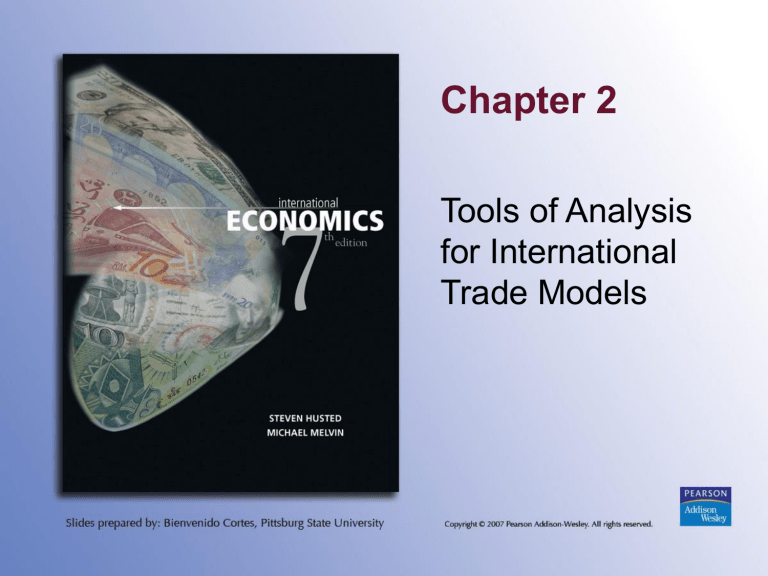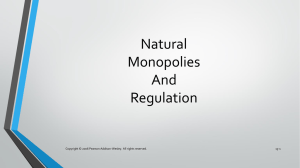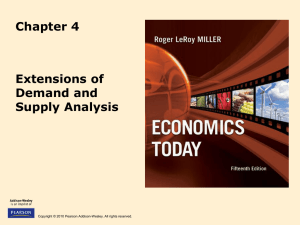
Chapter 2
Tools of Analysis
for International
Trade Models
Topics to be Covered
• Economic Methodology
• Assumptions of the Basic Model
• Price Line
• Production Possibilities Frontier
• Community Indifference Curves
• Closed Economy (Autarky) Equilibrium
• Measures of National Welfare
• National Demand and Supply Curves
Copyright © 2007 Pearson Addison-Wesley. All rights reserved.
2-2
Economic Methodology
• Model—an abstraction of reality.
• Geometric model vs. algebraic model
• Positive analysis—the analysis of economic
behavior without making recommendations
about what is or ought to be.
• Normative analysis—economic analysis
that makes value judgments about what is
or should be.
Copyright © 2007 Pearson Addison-Wesley. All rights reserved.
2-3
The Basic Model
• General equilibrium model—output,
consumption, prices, and trade are all
determined simultaneously for all goods.
• Beginning (7) assumptions
• Three tools of analysis
• Equilibrium solution
Copyright © 2007 Pearson Addison-Wesley. All rights reserved.
2-4
Assumption 1: Rational Behavior
• Economic agents are goal-oriented.
• Consumers maximize satisfaction
(subject to constraints).
• Firms maximize profit (subject
to constraints).
Copyright © 2007 Pearson Addison-Wesley. All rights reserved.
2-5
Assumption 2:
Two-country, Two-good World
• Two countries: America (A) and
Britain (B)
• Two goods: Soybeans (S) and
Textiles (T)
• Goods are identical in both countries.
• Some of both goods are always
consumed in both countries.
Copyright © 2007 Pearson Addison-Wesley. All rights reserved.
2-6
Assumption 3: No Money Illusion
• No money illusion means that
economic agents make decisions based
on changes in all prices.
• Nominal price—a price expressed in
terms of money.
• Relative price—a ratio of two
product prices.
Copyright © 2007 Pearson Addison-Wesley. All rights reserved.
2-7
Relative Price Rule
• If Ps / PT k ,
then 1 unit of S k units of T (in value)
or
1 unit of T 1/ k units of S (in value)
Copyright © 2007 Pearson Addison-Wesley. All rights reserved.
2-8
Tool of Analysis: Price Line
• Price Line (PL)—shows combinations of two
goods that can be purchased with a fixed
amount of money.
• Money (M) = Ps S PT T
• Slope of PL = relative price ( PS / PT )
• Shift of PL—caused by a change in income or
a change in both good prices.
• Rotation of PL—caused by a change in one
product price, other things constant.
Copyright © 2007 Pearson Addison-Wesley. All rights reserved.
2-9
Copyright © 2007 Pearson Addison-Wesley. All rights reserved.
2-10
Assumption 4:
Fixed Resources and Technology
• Tool of analysis: Production
Possibilities Frontier (PPF)
• PPF—shows maximum amount of one
good that can be produced given the
country’s fixed resources and
technology and the level of output of the
other good.
Copyright © 2007 Pearson Addison-Wesley. All rights reserved.
2-11
Features of a
Production Possibilities Frontier
• Full and efficient employment of
resources
• Slope of PPF = opportunity (social) cost
= T / S
• Shape of PPF: constant cost (linear PPF)
vs. increasing cost (bowed out PPF)
Copyright © 2007 Pearson Addison-Wesley. All rights reserved.
2-12
Copyright © 2007 Pearson Addison-Wesley. All rights reserved.
2-13
Assumption 5: Perfect Competition
in Both Industries in Both Countries
• Price equals marginal cost or
slope of PPF (T / S) = slope of PL (PS / PT )
• Labor unions are not present
Copyright © 2007 Pearson Addison-Wesley. All rights reserved.
2-14
Copyright © 2007 Pearson Addison-Wesley. All rights reserved.
2-15
Assumption 6: Resources
Perfectly Mobile Between Industries
• Resources earn the same payments in
both industries within a country.
Copyright © 2007 Pearson Addison-Wesley. All rights reserved.
2-16
Tool of Analysis: Indifference Curve
• Represents demand side of
the economy
• Indifference Curve—shows
combinations of two goods that yield
the same level of satisfaction to
a consumer.
Copyright © 2007 Pearson Addison-Wesley. All rights reserved.
2-17
Properties of Indifference Curves
• Individual-specific
• Downward-sloping
• Convex to the origin
• Higher curves indicate higher levels
of satisfaction
• Non-intersecting
Copyright © 2007 Pearson Addison-Wesley. All rights reserved.
2-18
Consumer Utility Maximization
• Consumer maximizes utility subject
to an income or budget constraint
(price line)
• Consumer equilibrium solution occurs
at the tangency point of an indifference
curve and the price line (refer to Figure
2.4(d), previous slide).
Copyright © 2007 Pearson Addison-Wesley. All rights reserved.
2-20
Assumption 7:
Community Indifference Curves
• Community Indifference Curves (CIC)
represent the consumption preferences
of the community.
• Problem: group preferences may not
be consistent
Copyright © 2007 Pearson Addison-Wesley. All rights reserved.
2-21
Copyright © 2007 Pearson Addison-Wesley. All rights reserved.
2-22
General Equilibrium Model
for a Closed Economy (Autarky)
• Autarky—self-sufficient country
before trade.
• Constant opportunity cost case vs.
increasing opportunity cost
• Equilibrium—tangency point of the
PPF and CIC
• Consumption point before trade
• Production point before trade
Copyright © 2007 Pearson Addison-Wesley. All rights reserved.
2-23
Copyright © 2007 Pearson Addison-Wesley. All rights reserved.
2-24
Copyright © 2007 Pearson Addison-Wesley. All rights reserved.
2-25
Measures of National Welfare
• Community Indifference Curve
• Gross Domestic Product (GDP)
• Nominal GDP can change due to
change in outputs and/or change
in prices.
Copyright © 2007 Pearson Addison-Wesley. All rights reserved.
2-26
Real GDP
• Increases in real GDP may imply
increases in national welfare.
Copyright © 2007 Pearson Addison-Wesley. All rights reserved.
2-27
Copyright © 2007 Pearson Addison-Wesley. All rights reserved.
2-28
Another Way of Showing
General Equilibrium for an Economy
• National Supply Curve—shows the
amounts of a good produced in a nation
at various relative prices for that good.
• National Demand Curve—shows the
amounts of national consumption of a
good at various relative prices.
Copyright © 2007 Pearson Addison-Wesley. All rights reserved.
2-29
Autarky Equilibrium
• Equilibrium autarky price—determined
at the intersection of National Demand
curve and the National Supply curve.
Copyright © 2007 Pearson Addison-Wesley. All rights reserved.
2-31
Copyright © 2007 Pearson Addison-Wesley. All rights reserved.
2-32
Trade Based on
Differences in Autarky Prices
• If country A has a lower autarky relative
price of S, then it has a comparative
advantage in S and a comparative
disadvantage in T.
• International trade can occur based on
comparative advantage.
Copyright © 2007 Pearson Addison-Wesley. All rights reserved.
2-33
Copyright © 2007 Pearson Addison-Wesley. All rights reserved.
2-34







